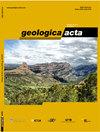伊朗克尔曼乌鲁米耶-多赫塔尔岩浆带东南部晚中新世切纳尔火山活动的成岩作用:来自地球化学、U-Pb地质年代和Hf同位素约束的证据
IF 1.3
4区 地球科学
Q2 GEOLOGY
引用次数: 0
摘要
切纳尔火山锥侵入伊朗乌鲁米耶-多赫塔尔岩浆弧东南部的德哈杰-萨尔迪耶火山沉积带东南部。阿达基特岩具有斑状构造,主要由流纹岩和达基特岩组成,通常由斜长石、角闪石和斜长石的表晶组成,还有罕见的钾长石,基质由斜长石、钾长石和石英组成。这些岩石的U-Pb锆石年龄分别为5.52±0.099Ma、5.46±0.12Ma和6.44±0.12Ma,放射性ɛHf(t)值为+3.1至+12.7。这些岩石的全岩地球化学分析表明,它们具有从钙碱性岩向霰石岩过渡的特征。研究岩石的地球化学特征,尤其是低Y(⁓4.43-16.2ppm)时的高Sr/Y(⁓51.6-136.8)和低Yb(⁓0.2-1.3ppm)时的高La/Yb(⁓28.4-118.4ppm),与高硅白蜡岩特征相一致。全岩正Eu/Eu*异常和锆石Ce/Ce*异常反映了氧化岩浆特征的影响,即研究区域的岩石起源于地幔源。切纳尔火山锥的高硅adakite地球化学特征支持在碰撞后环境中,在变质俯冲大洋板块的影响下,通过部分熔化修正地幔而形成。本文章由计算机程序翻译,如有差异,请以英文原文为准。
Petrogenesis of the late Miocene Chenar volcanism in the southeast Urumieh-Dokhtar magmatic belt, Kerman, Iran: evidence from geochemical, U-Pb geochronologic, and Hf isotopic constraints
The Chenar volcanic cone intruded the southeastern part of the Dehaj-Sarduiyeh volcano-sedimentary belt, in the southeast Urumieh-Dokhtar magmatic arc in Iran. The adakitic rocks, with porphyritic texture, mainly consist of rhyodacites and dacites,commonly comprised of phenocrysts of plagioclase, hornblende and biotite, with rare K-feldspar in a groundmass composed of plagioclase, K-feldspar and quartz. They yielded U-Pb zircon ages of 5.52±0.099Ma, 5.46±0.12Ma, and 6.44±0.12Ma, and radiogenic ɛHf(t) values ranging from +3.1 to +12.7. The whole-rock geochemical analysis of these rocks reveals transitional calc-alkaline to shoshonitic characteristics.
The geochemical characteristics of the study rocks, particularly their high Sr/Y (⁓51.6-136.8) at low Y (⁓4.43–16.2ppm) and high La/Yb (⁓28.4–118.4ppm) at low Yb (⁓0.2–1.3ppm), are coherent with a high silica adakitic signature. The whole-rock positive Eu/Eu* anomaly and zircon Ce/Ce* anomaly reflect the effects of an oxidized magmatic signature where the rocks of the study area originated from a mantle source. The high silica adakite geochemical characteristics of the Chenar volcanic cone support formation by partial melting of the modified mantle under the influence of metasomatized subducted oceanic slab in a post-collisional environment.
求助全文
通过发布文献求助,成功后即可免费获取论文全文。
去求助
来源期刊

Geologica Acta
地学-地质学
CiteScore
2.50
自引率
6.70%
发文量
13
审稿时长
>12 weeks
期刊介绍:
- Relevant conceptual developments in any area of the Earth Sciences.
- Studies presenting regional synthesis.
- Thematic issues or monographic volumes presenting the results from one or more research groups.
- Short papers reflecting interesting results or works in progress.
- Contributions and results from Research Projects, Workshops, Symposiums, Congresses and any relevant scientific activity related to Earth Sciences.
- Geologica Acta aims to stimulate rapid diffusion of results and efficient exchange of ideas between the widespread communities of Earth Science researchers (with special emphasis on Latinamerica, the Caribbean, Europe, the Mediterranean
 求助内容:
求助内容: 应助结果提醒方式:
应助结果提醒方式:


